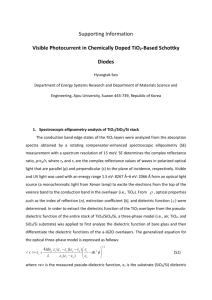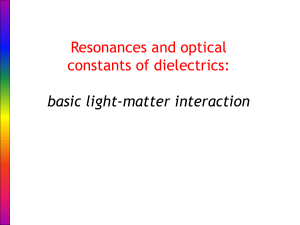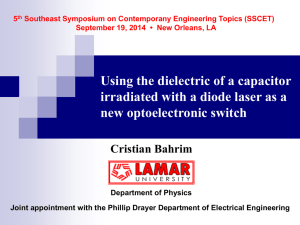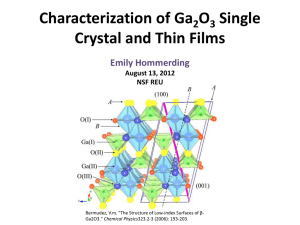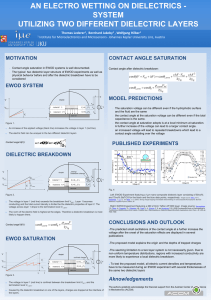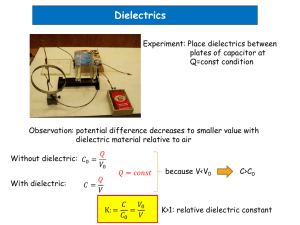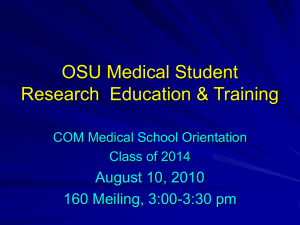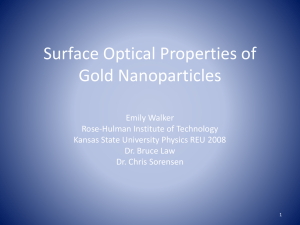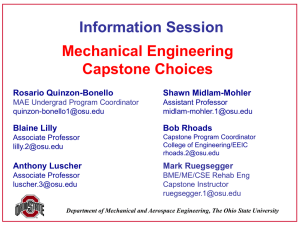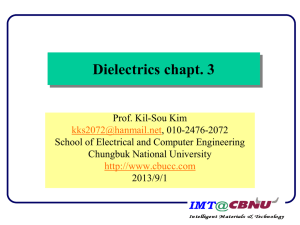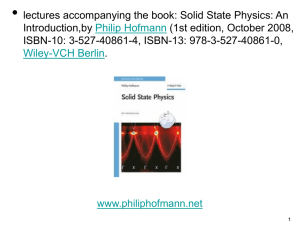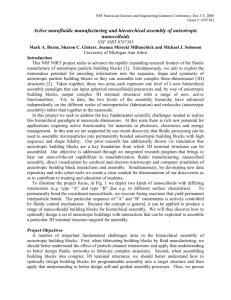Dispersion Engineering with Amorphous Metamaterials
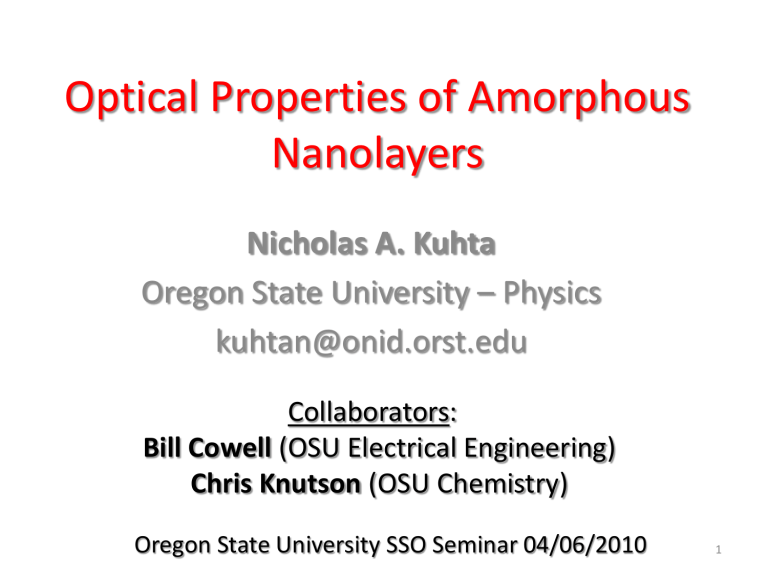
Optical Properties of Amorphous
Nanolayers
Nicholas A. Kuhta
Oregon State University – Physics kuhtan@onid.orst.edu
Collaborators:
Bill Cowell (OSU Electrical Engineering)
Chris Knutson (OSU Chemistry)
Oregon State University SSO Seminar 04/06/2010
1
Outline:
1.
Introduce Metamaterials/Plasmonics and discuss modern applications.
2.
Overview fabrication and characterization of our bulk and layered amorphous metal-dielectric metamaterials.
3.
Show the optical properties of our structures – interesting conductivity response, anisotropic, effective medium, hyperbolic dispersion.
2
Controlling Light at the Nanoscale
DNA sensing -Gold nanoparticle cluster size/dimension changes color.
Lee et. al Nano Lett. 9, 4564 (2009)
Roman Goblet from 4 th century A.D.
Gansel et. Al Science 325, 1513 (2009) 3
More Nano-Optics
CNT photocurrent – Minot Group OSU
Hoffman et. al Nature Materials (2007)
Pendry et. al Science 312 (2006)
IBM – FET with graphene channel (10GB/s) 4
Metamaterial Application Goals:
1.
Subwavelength imaging – beating the diffraction limit
2.
Superfocusing – sub-diffraction
J. Lee - Acoustic Microscope
3.
Cloaking – Super-absorbers (optical black hole)
4.
Improved data storage via enhanced nanocontrol
5.
High speed optoelectronic/photonic devices (Optical Computing)
6.
New Sensor technology for Biological species
7.
Dispersion Engineering (this work)
8.
New Physics!!!
McGehee – plasmonic solar cells
Hulst –
Single molecule nanoscale probe
Clark – split ring resonator
5
Amorphous Metal Nanofabrication – DC Magnetron Sputtering
Targets:
1. ZrCuAlNi
2. TiAl
3
Experimental Technique:
• Positively Charged Argon Plasma (color) – ejects atomic species from metal target.
• Neutral ejected particles travel and are deposited on substrate in thin film form.
• Pressure controls deposition rate (scattering)
Pros:
• Uniform high deposition rate
• Targets provide easy control of stoichiometry
•
Cons:
Requires vacuum apparatus
Cowell, Masters Thesis OSU (2010)
6
Dielectric Thin Film Deposition – Solution Spin Coating
Experimental Technique:
• Inorganic aqueous-solution-processed oxide sample (ALPO)
• Utilize surface tension to produce atomically smooth layers using spin-coating.
• After the timed spin put on hot plate to remove water. (MOM bonds)
Pros:
• Very inexpensive
• Highly accurate – reproducible
• Scalable
Cons:
• Limited Material Set
• Getting materials in solution
Knutson et. al (in preparation) 7
TEM micrographs – Planar Metal-Dielectric Nanostructures
TiAl
3
– ALPO stack system ZrCuAlNi – ALPO stack system
Cowell et. al Applied Materials
& Interfaces (2011)
8
Electron Diffraction Schematic
Speckled pattern = Crystalline Structure (long range spatially repeating order)
Diffuse pattern = Amorphous Structure (no structure - disordered)
9
Amorphous Morphology – Electron Diffraction single crystalline
Amorphous (no long range order)
10
Light-source:
Xe Lamp
(190nm-2400nm)
Spectroscopic Ellipsometry - Reflectance
Xe Lamp Spectrum
Measurement parameters:
• Measure reflectance for angles between 20 and 80 degrees
• Reflectance measurements range from 300nm to 1500nm
• Both TE and TM polarization reflectance is measured
• Negligible coupling between output TE and TM polarization states
11
Single Layer (Thick Film) Reflectance - Ellipsometry
200nm - TiAl
3
284nm - ZrCuAlNi
12
Extracting Dielectric Response
In optically thick metals reflection only comes from the top interface
R
TM
R
TE
2
2
2
2
2
2
Note we’re using non-magnetic materials n
13
Gold – Dielectric Response
( )
exp i
z c
Aluminum – Dielectric Response
Palik,"Handbook of Optical Constants of Solids," Academic Press (luxpop.com)
14
Copper – Dielectric Response
Titanium – Dielectric Response
Palik,"Handbook of Optical Constants of Solids," Academic Press.
15
As with all plasmonic systems loss plays a major role.
Bulk Dielectric Constants
Note the different response for each metal!
n
( )
exp i
z c
16
Quasistatic Effective Medium Theory (Planar)
Due to the small thickness of each material layer with respect to the laser wavelength
(quasistatic) the material responds as an average
anisotropic effective medium.
average
z
xy
D
D
D
E
E
E
d
E
1 1 1
d d
1
d
2
E
2 2 2 d E
1 1
d E
2 2 d
1
d
2
d
1 1
d d
1
d
2 2
2
d D
1 1
d D
2 2 d
1
d
2 d D
1
/
1
d D
2 d
1
d
2
/
2
( d
1 2 1 d
2 1
d d
2
1 2
)
17
Anisotropic Dispersion Equation and Poynting Vector isotropic kx
2 kz
2
2 c
2
S
c
2
4
k anisotropic
S
kx
z
2 kz
xy
2
2 c
2
, x z
kx kz
z xy
18
Anisotropic Dielectric Response – Effective Medium
xy
d
d m m d m
d
d d d
z
m d d d m
( d
m
d d d m d
)
19
Multi-Layer Optical Reflectance – EMT Model
10 bilayers – 8nm (ZrCuAlNi), 8nm AlPO 10 bilayers – 4.7nm TiAl
3
, 11.3nm AlPO
20
error
R measured
R theory
R measured
Error Analysis
21
Acknowledgements
OSU Electrical
Engineering:
William Cowell –
(Sputtering Metal)
John Wager
OSU Chemistry:
Christopher Knutson –
(Spin Coating Dielectric)
Doug Keszler
OSU Material Science:
Brady Gibbons -
Ellipsometry
OSU Physics:
David McIntyre
Advisor:
Viktor Podolskiy
22
Conclusions:
1. Ultra-thin nanostructures with atomically smooth interfaces reproducibly fabricated.
2. Bulk amorphous metals display interesting AC conductivity response.
3. Optical properties are consistent with anisotropic hyperbolic effective material response.
Applications and Outlook:
1. Dispersion Engineering (customized index of refraction)
2. Optical Filters
3. Subwavelength light compression
4. Waveguide systems
5. Stealth Coatings
6. Solar Cells (more than reflectors?)
7. Anisotropic Thermal Conduction
23
